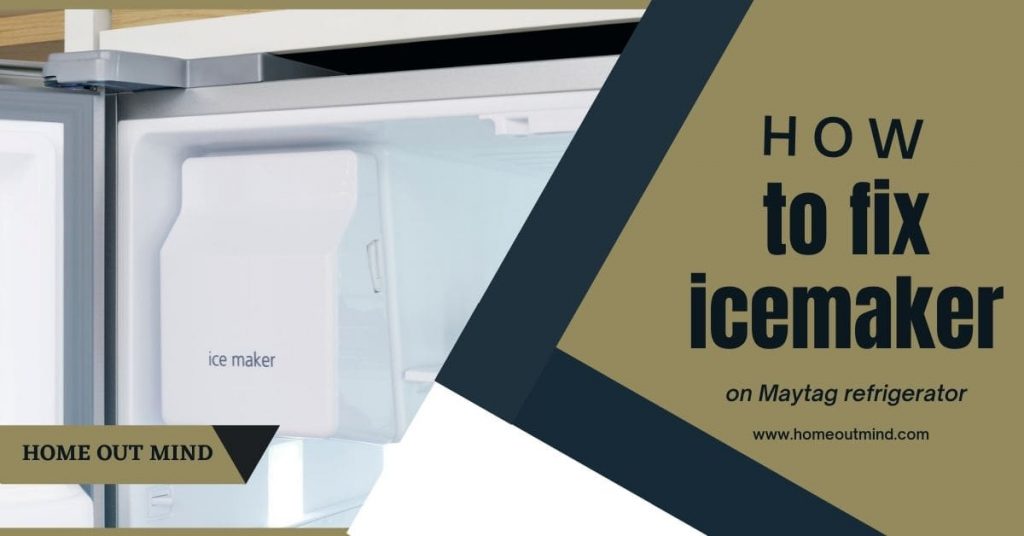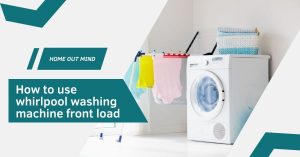Are you wondering How to fix ice maker on maytag refrigerator? Is your Maytag ice maker not producing ice anymore or it’s not working anymore?
You’re in the right places where we’ll show what causes these issues and How to fix ice maker on maytag refrigerator.

Before you start you may know:
How an ice maker works?
A traditional ice maker in today’s refrigerators is typical of the heat release design. Essentially, how this works is they will fill with water, through a fill valve that is located at the back of your refrigerator, water will enter the ice maker into the fill cup and fill the mold.
Freezing temperatures will turn that water into ice and a sensor inside the head of that ice maker will detect the mold is at freezing temperature and initiate a harvest cycle.
There is a small motor located inside that control head, that will rotate this ejector arm to push the ice cubes out.
at the same time, a heater on the bottom is turned on, warming the mold up enough to break the bond between the ice and the mold. Once that bond is broken, that ejector arm will push the cubes out and dump them into
a bin.
In the last portion of that cycle, the ice maker control will turn on the water valve again for about seven to nine seconds to fill the mold to begin the cycle all over again.
- make sure the appliance is unplugged or the circuit breakers are off so there’s no chance of electrocution.
- make sure you turn off the water supply underneath the sink.
How to fix ice maker on maytag refrigerator causes & fixing
Cause1. Water valve.
Fixing:
Step1:
in determining whether our water valve is working properly or not is check your water supply:
1) pulling the refrigerator forward, enough that we can access the back of it.
2) locate the manual shut-off valve and turn off the water supply.
3) disconnect the inlet to the water valve and then turn your manual valve on to verify that we do actually have water pressure at the valve.
If you’re satisfied that that is proper
4) look at the outlet tubing that goes to the ice maker.
Most water valves on refrigerators, if they are dual or triple or quadruple valves, the quarter-inch tubing will be the one that runs to the ice maker.
You can typically just follow that tubing up the back of the refrigerator and it will enter the back of the cabinet where the ice maker is located.
5) check that tubing to make sure that it’s not restricted or frozen.
disconnect that tubing and then you can blow through it and if the air will pass through the tube, you can assume that the tubing is fine.
You should check in regards to the water valve is if your refrigerator has a filter on it, it may be restricted or plugged.
If your Maytag has a dispenser, simply try your dispenser and see what the waterfall is like, and if it’s very low or none at all, you would suspect that you have a bad filter and will need to change that.
if we’ve determined that we have no restrictions in our water line and we do have water pressure,
Step2. check the continuity of the solenoid on the valve that is associated with the ice maker.
1) Locate the solenoid and then using a multimeter you’ll check for continuity across those two terminals.
If you verify that we have continuity, you know that the portion of the valve is okay.
There is still a possibility that you have a mechanical defect inside of the valve.
The only way to really determine that is to have a water inlet and outlet to it and then apply power to it, either with a test cord or using the ice maker control itself.
2) demonstrate using a test cord to check that valve.
3) attached a test cord to this valve.
Make sure that you use insulated terminal ends on your test cord and normally.
the valve would still be connected to the refrigerator with your inlet water supply coming into it and tubing coming out going to the ice maker.
4) Put it into a live outlet and water should flow through that valve.
If it does not, you know that you have a mechanical defect within the valve.
if you don’t have access to a test cord to do a live check on the valve
if your model has two solenoids on it, one for the water dispenser and one for the ice maker, you could reverse those two harnesses,
connect the one that would go to the dispenser solenoid under the ice maker solenoid and activate the water dispenser at the front of the refrigerator and that should turn on the water valve for the ice maker and water should flow.
If it does not, again, you would suspect an internal defect in that water valve.
Once you’ve verified that our inlet water valve was working properly, and we still are not getting any water through to the ice maker.
you can suspect that, perhaps, the control on the front of the ice maker is not sending power down to that valve.
- heck is the harness that connects between the ice maker control and the harness inside of your refrigerator.
- Make sure that is plugged in securely on both ends.
Once is secure you may suspect that you have a problem inside the icemaker head.
As mentioned earlier, as part of the harvest cycle on an ice maker, it will turn on the water valve at the very end of that harvest cycle for about seven to nine seconds.
Step3. Test the water valve.
1) pop the cover off the front and you’ll note is a dial around the center of that and on the outside of it, you’ll note that there are some test points that are indicated with some letters.
2) Down in this position you’ll see one that is marked with a V and another one that is marked with an L.
- The L indicates that it is a live voltage test point.
- he V indicates that is the port that goes to the fill valve.
3) If you made yourselves a jumper wire, with either number 12 or number 14 gauge solid wire, you’ll strip about an inch of the insulation off of either end, Leave lots in the middle so that we can grasp it safely because this will be a live voltage test.
4) With the ice maker in place and the bail leaver down,
- insert that jumper between the L and the V terminals, hold it in place and the water valve should come on.
If it does, you can suspect that the problem lies inside the control head on the ice maker.
Cause2. Ice maker.
it’s where the ice is made inside the refrigerator, there are several different styles of ice makers the most popular
kinds are the Halfmoon style in the Flex tray-style they both work the same way they have a control section that controls the cycles of the icemaker.
There is a tray where the ice is made ice makers can be located in several different places depending upon your style of refrigerator usually they’re mounted in the freezer but on some models, it can be located in the fresh food section.
there are a few things to check before we can start troubleshooting:
1) icemakers are must be in the down position or the switch must be in the opposition.
2) make sure the freezer is set below ten degrees Fahrenheit.
verify the temperature required for the ice maker to work usually it’s ten degrees Fahrenheit the freezer should actually be set to around zero degrees Fahrenheit for maximum ice production.
3) if your freezer is a little warm:
- check the condenser coils.
4) if they’re dirty the freezer will run warmer than normal.
5) make sure the house water pressure is good.
The system needs a certain pressure to work properly.
if the icemaker isn’t making any ice it could be that it’s failed most common things to fail are:
- the mold thermostat
- the gears
- the motor
- switches inside the control
if any of these have failed the ice maker will stop making ice.
usually, when it fails the ice maker has had an age we’re changing how the whole thing might be the best choice but if you want to troubleshoot further depending upon your design you may be able to buy the individual pieces.
there have been many different styles of ice makers used over the years here are two very popular ice makers like we mentioned before the Halfmoon style and the flex Tre style
the parts of the Halfmoon style you have the ice maker control which has the shut-off
contacts drive motor and the gear the mold thermostat and the mold heater are on the ice mold itself.
Fixing:
Method1.
Step1. use a multimeter to test the parts of an ice maker.
1) set your meter to ohms
your meter automatically detects whatever ohms are coming in, but you may need to set your meter to read the proper ohm level.
2) remove the cover front cover of the ice maker just pop it out.
3) test the mold heater stick a probe into the holes marked ( l ) and ( H ) it should read around 72 ohms.
4) check the motor stick the probes into the ( L ) and ( M ) holes the meter should read between forty-four
hundred and eighty-eight hundred ohms
5) stick the probes into the ( V ) and ( n ) holes to check the external water valve solenoid it should read around three hundred ohms.
Note: any of the readings can be a little off one way or another but if they’re completely off or you’re not getting a reading at all the part will need to be replaced.
6) check the mold thermostat.
You need to see if it has continuity you’re not looking for a specific value, just to see if the meter gets a reading.
- stick the probes into the ( T ) and ( H ) holes.
- measure the thermostat when it’s below 15 degrees Fahrenheit it should have continuity when it’s cold if it doesn’t then it needs to be replaced.
- let the thermostat warm up so it’s above 15 degrees.
if you don’t want to unplug the freezer to let it warm up you may want to take the icemaker out, In order to test it once it warms up it should no longer have continuity if it does that means it’s failed and you’ll need to replace it.
Method2.
a lot of the newer style ice makers both flex tray and Half Moon have a test procedure to determine if the ice maker is bad.
there’s usually a test button or a small hole where you insert a paperclip to start the procedure.
if you have a test button usually press and hold it for a few seconds to start the test.
if the ice maker doesn’t pass the test procedures it’s more than likely failed and will need to be replaced.
Cause3. water filter assembly.
the water filter assembly filters the water as it comes into the fridge.
depending upon your design the water filter assembly is made up of:
- a water filter
- a water filter head
- a water filter housing
the assembly is usually located inside the fresh food section or down by the kick panel.
Fixing:
if you notice water pooling underneath the assembly you’ll first:
1) take out the filter and check for any cracks or damage that can be causing a leak.
2) check the o-rings on the end of the filter.
3) reinstall the filter and make sure it’s seated properly.
If it’s still leaking:
4) take the filter back out.
5) inspect the head or housing whichever you have to make sure it’s not cracked or damaged.
6) check to see if your lines are removable and try to reseat them.
Note: if you notice the filter or housing is damaged or still leaking you’ll need to change out the damaged part.
Cause4. Water lines.
the water lines and connectors carry water throughout the refrigerator the water lines and connectors are all made out of plastic.
they usually come in quarter and 5/16 in sizes.
the connectors seal in a couple of different ways one style has orange inside and the other uses a compression fitting.
there are various water lines and connectors throughout the machine.
Fixing:
if you’re getting a leak in a certain area and you’ve already checked everything else you should:
1) look at the lines and connectors inspect all the lines for any holes or cracks where the water might be dripping.
2) inspect the connectors to make sure they’re not leaking.
3) remove the line and try to reseat it.
if it doesn’t work you’ll have to replace the connector.
many times the lines are sold individually but if you just need to replace a short section you
can get a small piece of line in a couple of connectors and splice in a new piece.
Read also:
- How to install Kitchenaid ice maker?
- How to install an automatic ice maker?
- How to install ice maker in whirlpool refrigerator?
- How to install ice maker frigidaire?
- How to clean an ice maker?
- How to clean a Scotsman ice maker?
- How do you clean a portable ice maker?
- How to remove an ice maker?
- How to replace a Frigidaire ice maker?
- How to replace ice maker in ge profile refrigerator?
- How to repair Samsung refrigerator ice maker?
Bonus tips:
Tip1.
the amount of food in a freezer can affect the production of ice, more food in the freezer allows temperatures to be more stable.
Tip2. Frozen fill tube.
There is a small fill tube that fills the ice maker up with water so pull out the ice tray and inside you want to find where the water enters into the ice maker and many times if you don’t have enough water pressure or for other reasons that small fill tube has been frozen not allowing water to get into the ice maker.
Defrost the fill tube if it’s frozen:
grab a hairdryer and you can thaw it out by blowing the hairdryer on that small tube which should thaw that ice out and allow water to then freely flow.
Tip3. if you’ve recently had your fridge installed wait up to 24 hours for ice prediction.
Tip4. faulty door switch
many of the freezers have a door switch that controls not only the ice maker but also the lights in the refrigerator.
when you open the refrigerator or the freezer then your ice maker may not be working just due to a faulty door switch.


